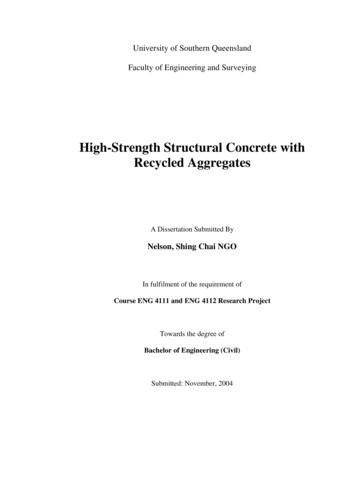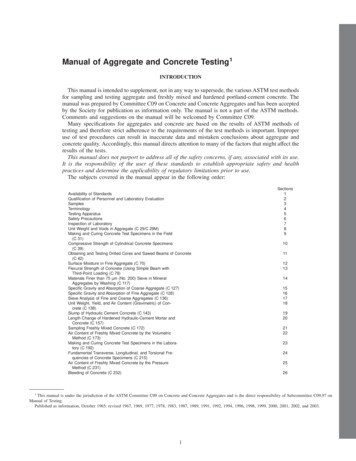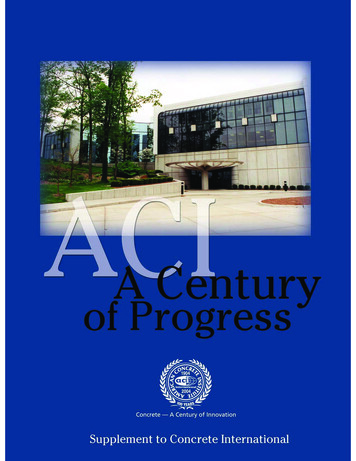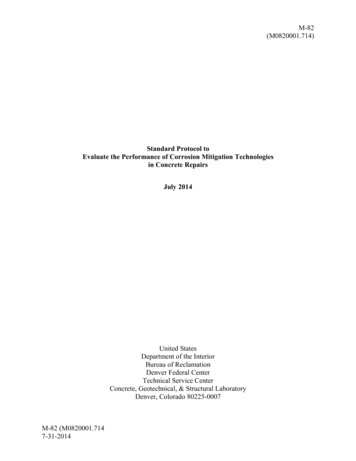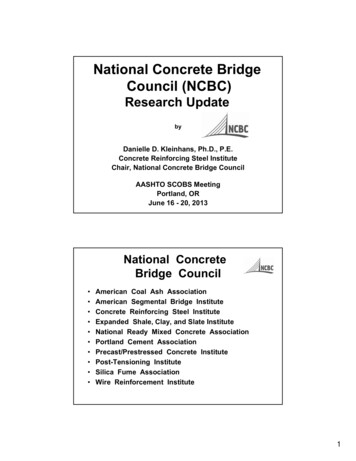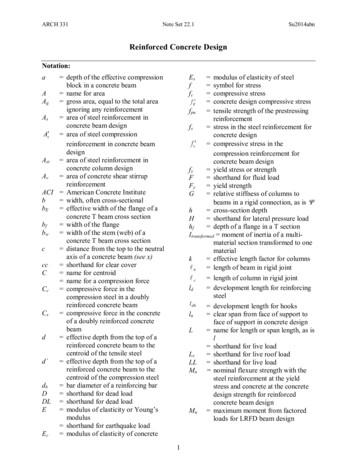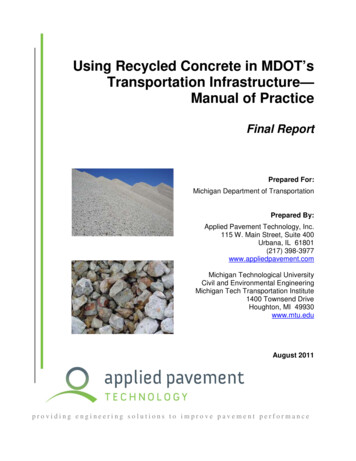
Transcription
Using Recycled Concrete in MDOT’sTransportation Infrastructure—Manual of PracticeFinal ReportPrepared For:Michigan Department of TransportationPrepared By:Applied Pavement Technology, Inc.115 W. Main Street, Suite 400Urbana, IL 61801(217) 398-3977www.appliedpavement.comMichigan Technological UniversityCivil and Environmental EngineeringMichigan Tech Transportation Institute1400 Townsend DriveHoughton, MI 49930www.mtu.eduAugust 2011providing engineering solutions to improve pavement performance
Michigan DepartmentOf Transportation1959 (10/08)1. REPORT NO.TECHNICAL REPORTDOCUMENTATION PAGE2. GOVERNMENT ACCESSION NO.Report Number RC-15443. MDOT PROJECT MANAGERJohn Staton4. TITLE AND SUBTITLE5. REPORT DATEAugust 2011Using Recycled Concrete in MDOT's TransportationInfrastructure - Manual of Practice6. PERFORMING ORGANIZATION CODE7. AUTHOR(S)8. PERFORMING ORG. REPORT NO.Ton Van Dam, Kurt Smith, Carrie Truschke, Stan Vitton9. PERFORMING ORGANIZATION NAME AND ADDRESSMichigan Tech University1400 Townsend DriveHoughton, MI 4993110. WORK UNIT NO. (TRAIS)11. CONTRACT NO.P008558511a. AUTHORIZATION NO.12. SPONSORING AGENCY NAME AND ADDRESS13. TYPE OF REPORT & PERIOD COVEREDMichigan Department of TransportationOffice of Research and Best Practices425 W. Ottawa StreetLansing, MI 48909FINAL (February - August 2011)14. SPONSORING AGENCY CODE15. SUPPLEMENTARY NOTES16. ABSTRACTCrushed concrete aggregate (CCA) is granular material manufactured by removing, crushing, andprocessing old concrete for reuse as an aggregate source in new construction. Although the MichiganDepartment of Transportation (MDOT) has used CCA since the 1980s, issues in the performance ofsome of the early projects currently limit its use to primarily bound and unbound drainable bases beneathconcrete pavements. Some of the performance issues on the early projects developed because of theunique characteristics and properties of CCA materials, such as increased absorption, lower specificgravity, and reduced abrasion resistance.Although there are potentially some limitations associated with the use of CCA, the effectivecharacterization of these materials during their production and throughout the design and constructionprocess can help lead to their successful use and application. This document is intended to help guideMOOT engineers in using CCA in the State's transportation infrastructure, with particular focus onpavement applications. Information is provided by chapter on the processing and production of CCA, onthe physical, mechanical, and chemical characteristics of CCA, and on the use of CCA in base layers,asphalt paving layers, and concrete paving layers; these are presented in conjunction with MDOT'sstandard specifications for construction and and special provisions to indicate the Department's currentusage policies policies and recommendations regarding CCA.17. KEY WORDS18. DISTRIBUTION STATEMENTNo restrictions. This document is available tocrushed concrete aggregate (CCA), recycled concrete aggre the public through the Michigan Department ofTransportation.19. SECURITY CLASSIFICATION - report20. SECURITY CLASSIFICATION - page21. NO. OF PAGES 22. PRICEUnclassifiedUnclassified44
ii
Using Recycled Concrete in MDOT’s Transportation Infrastructure—Manual of PracticeTABLE OF CONTENTSChapter 1. Introduction . 1General Overview . 1Benefits and Limitations . 1Potential Uses and Applications . 2Michigan DOT Experience with CCA. 3Purpose and Overview of Guideline Document . 5Chapter 2. Processing and Production of Crushed Concrete Aggregate . 7Introduction . 7Pavement Characterization and Preparation . 7Concrete Breaking and Removal . 9Crushing and Sizing Operations . 10Crushing . 10Steel Removal . 12Stockpile Management. 13Checklist: CCA Processing and Production . 13Chapter 3. Crushed Concrete Aggregate Properties and Applications . 15Introduction . 15General Properties and Characteristics of CCA. 15Mortar Content . 15Fineness and Composition of Original Cement . 16Particle Shape and Texture . 16Absorption Capacity . 16Specific Gravity . 16Abrasion and Soundness . 17Chloride Content . 17Freeze-Thaw Durability . 17Alkali-Silica Reactivity. 17Accommodating CCA Materials in Pavement Applications . 18Checklist: CCA Properties and Applications . 19Chapter 4. Use of Crushed Concrete Aggregate in MDOT Base Layers . 21Introduction . 21MDOT Requirements for Using CCA in Dense-Graded Base Layers . 21MDOT Requirements for Using CCA in Open-Graded Drainage Course . 22MDOT Requirements for Rubblized Concrete Base Layers . 23Checklist: CCA for Use as Base Material. 24Chapter 5. Use of Crushed Concrete Aggregate in MDOT Asphalt Paving Layers. 25Introduction . 25CCA Use in Asphalt Mixtures . 25MDOT Requirements for the Use of CCA in Asphalt Mixtures . 26Construction Considerations When Using CCA as Aggregate in HMA . 26Checklist: CCA for Use With Asphalt Material . 26Applied Pavement Technology, Inc.iii
Using Recycled Concrete in MDOT’s Transportation Infrastructure—Manual of PracticeChapter 6. Use of Crushed Concrete Aggregate in MDOT Concrete Pavement Mixtures . 29Introduction . 29Unique Properties of Concrete Made With CCA . 29Fresh Concrete Properties . 29Hardened Concrete Properties . 30Construction Considerations When Using CCA Concrete . 32Pavement Design Considerations When Using CCA Concrete . 32MDOT Requirements for the Use of CCA in New Concrete Mixtures . 33Checklist: Use of CCA in Concrete Pavement Mixtures . 33Chapter 7. Summary . 35References . 37ivApplied Pavement Technology, Inc.
Using Recycled Concrete in MDOT’s Transportation Infrastructure—Manual of PracticeLIST OF FIGURESFigure 1. Pavement demolition equipment: a) diesel hammer, b) multi-head pavement breaker,and c) resonant breaker (Hoerner et al. 2001) . 9Figure 2. Rhino horn (ACPA 2009). 10Figure 3. Schematic illustration of crushing operations (Hoerner et al. 2001) . 11Figure 4. Schematic illustrations of various types of crushing equipment (ACPA 2009). 12LIST OF TABLESTable 1. Summary of allowable use of CCA based on 2012 MDOT Standard Specifications forConstruction (MDOT 2012). . 4Table 2. Potential contaminants in PCC pavement rubble (adapted from Hoerner et al. 2001). . 8Table 3. Checklist for CCA processing and production. . 13Table 4. Comparison of typical natural aggregate and CCA properties (Snyder et al. 1994). . 15Table 5. Using CCA as unbound granular material (based on ACPA 2009; Hiller et al. 2011). 18Table 6. Checklist for CCA properties and applications. . 19Table 7. MDOT gradation requirements for dense-graded aggregates. . 22Table 8. Additional MDOT physical requirements for dense-graded aggregates. . 22Table 9. MDOT requirements for open-graded aggregates (based on Special Provision03SP303(A), Open-Graded Drainage Course, Modified). . 22Table 10. MDOT requirements for open-graded drainage course for CTPB (based on SpecialProvision 03CT303(A140). . 23Table 11. Checklist for CCA for use as base material. . 24Table 12. Checklist for CCA for use with asphalt material. . 27Table 13. Effects of CCA on fresh concrete properties and behavior (ACPA 2009). . 30Table 14. Effects of CCA on hardened concrete properties and behavior (ACPA 2009). . 30Table 15. Checklist for CCA for use in concrete paving layers. . 34Table 16. Summary of allowable use of CCA based on 2012 MDOT Standard Specifications forConstruction (MDOT 2012). . 36Applied Pavement Technology, Inc.v
Using Recycled Concrete in MDOT’s Transportation Infrastructure—Manual of PracticeLIST OF w/cmWMAviAmerican Association of State Highway and Transportation OfficialsAmerican Concrete Pavement AssociationAverage daily trafficAlkali-silica reactivityAmerican Society for Testing and MaterialsAggregate Wear IndexCommercial average daily trafficContinuously reinforced concrete pavementsCoefficient of thermal expansionCement-treated permeable baseCrushed concrete aggregateDurability crackingFederal Highway AdministrationHot-mix asphaltJointed plain concrete pavementJointed reinforced concrete pavementMichigan Department of TransportationMechanistic-empirical pavement design guideMaterials-related distressMichigan Test MethodNational Cooperative Highway Research ProgramPortland cement concreteSupplementary cementitious materialsWater-to-cementitious materials ratioWarm-mix asphaltApplied Pavement Technology, Inc.
Using Recycled Concrete in MDOT’s Transportation Infrastructure—Manual of PracticeCHAPTER 1. INTRODUCTIONGeneral OverviewThe recycling of concrete pavements—crushing of old concrete slabs and reusing the crushedmaterial in some other pavement application—has been used in the U.S. since the 1970s(Hoerner et al. 2001). At that time, common reasons for concrete recycling were noted to beconservation of resources, limited availability of aggregates, minimizing solid waste disposalissues, and reductions in overall construction costs (Yrjanson 1989), all important factors thatresonate even stronger in today’s climate of sustainable stewardship and environmentalawareness.Data collected from 2009 indicates that concrete pavements are recycled for transportationinfrastructure applications in at least 41 states; moreover, about 140 million tons of crushedconcrete aggregate (CCA) are produced in the U.S. per year (ACPA 2009). The material hasbeen used in applications ranging from placement in various paving layers (surface, base,subbase) and as fill and embankment material (ACPA 2009).CCA is granular material manufactured by removing, crushing, and processing portland cementconcrete (referred to simply as concrete in this guide) for reuse in similar situations as virginnatural aggregate (FHWA 2007). However, CCA has different properties than natural aggregate,largely because the resultant crushed material is composed of both the original natural aggregateand reclaimed mortar, which significantly affects the properties and behavior of materialsproduced with CCA unless specific steps are taken to account for it in the design andconstruction process. Moreover, the composition of CCA can be highly variable, and in additionto aggregates and reclaimed mortar may contain contaminates such as soil and clay balls, jointsealant, and asphalt or other construction waste (ACPA 2009). Further, freshly processed CCAis highly alkaline and may contain chlorides that may limit is use or applicability (Hiller et al.2011). Nevertheless, when its characteristics are properly considered and accounted for, CCAcan be used effectively in a number of transportation infrastructure applications.Benefits and LimitationsAs noted above, perhaps the two primary benefits associated with the use of CCA are resourceconservation (reducing the need for natural aggregate) and reducing or eliminating solid wastedisposal issues. Although the environmental considerations are usually believed to be of primaryinterest, there are often significant economic benefits as well, since the use of CCA reduces theneed for natural aggregate and for landfill disposal. Furthermore, in the case of pavementreconstruction, the old concrete will still require demolition and removal, so the cost of the CCAis reduced only to the cost of crushing and processing the material. Further, if the material canbe processed on site, fuel consumption and related transportation costs are also reduced.The last several years have seen a focus on sustainability, which has been characterized as abalance between economic, environmental, and societal needs and impacts (Van Dam and Taylor2009). If properly administered, the use of CCA could potentially play an integral role infulfilling sustainability needs in each of these three areas, and thus can contribute to thesustainability of pavement construction projects. In fact, the use of recycled materials is directlyconsidered and earns credit in several infrastructure sustainability rating systems that haverecently been developed, such as Greenroads (Muench et al. 2010) and the SustainableHighways Self-Evaluation Tool (FHWA 2011).Applied Pavement Technology, Inc.1
Using Recycled Concrete in MDOT’s Transportation Infrastructure—Manual of PracticeAt the same time, CCA have a number of unique characteristics and properties that must beconsidered during the design and construction process. For example, CCA typically exhibits thefollowing characteristics when compared to natural aggregates (Snyder et al. 1994; Hiller et al.2011): Lower specific gravity, which decreases with increasing amount of reclaimed mortar.Higher absorption, which increases with increasing amount of reclaimed mortar.Greater angularity.Increased abrasion loss, which increases with increasing amount of reclaimed mortar.In addition, CCA may contain unhydrated cement, which may alter its behavior and complicatestockpiling, especially the fine material. Leaching of calcium hydroxide from the CCA may alsobe a problem when used as a drainage layer or near a water source, as it will react withatmospheric carbon dioxide forming calcium carbonate, which will clog filter fabrics (Snyderand Bruinsma 1996; ACPA 2009). Finally, the fines produced during the crushing operation(those passing the No. 4 sieve) are coarse and angular, which tend to make CCA concretemixtures very harsh and difficult to work.It is important to recognize that not all CCA is appropriate for reuse in all applications. Forexample, CCA made from concrete exhibiting materials-related distress (MRD) such as alkalisilica reactivity (ASR) or D-cracking may preclude its reuse in concrete unless certain mitigationmethods are employed (ACPA 2009). Additionally, CCA may have high chloride contents dueto extended exposure to deicing chemicals while in service, which may make it unsuitable foruse in reinforced concrete. And, the low abrasion resistance may lead to poor performance in anapplication where intimate aggregate interlock is relied upon for load transfer (for example, inundoweled joints or at transverse cracks of reinforced slabs). Again, these factors don’tnecessary prevent the use of CCA, but just underscore the importance of adequatelycharacterizing the materials and accounting for their properties as part of the design andconstruction process.Potential Uses and ApplicationsAs previously noted, CCA can be broadly used in many of the same applications as naturalaggregate, including the following (ACPA 2009): Unbound (granular) base and back fill (including both dense-graded and free-drainingbases).Cement-stabilized base (permeable and dense-graded).Asphalt-stabilized base (permeable and dense-graded).Concrete mixtures (surface layers, lean concrete base).Asphalt pavement mixtures.Granular fill.Miscellaneous applications, such as soil stabilization, pipe bedding, landscape materials,and railroad ballast.Recycling can be performed on any existing concrete pavement type: jointed plain concretepavements (JPCP), jointed reinforced concrete pavements (JRCP), and continuously reinforcedconcrete pavements (CRCP).2Applied Pavement Technology, Inc.
Using Recycled Concrete in MDOT’s Transportation Infrastructure—Manual of PracticeCoarse CCA (defined as that retained on the No. 4 sieve) can be used in most pavementapplications, but the use of fine CCA (passing the No. 4 sieve) is more limited, particularly whenconsidered for use in new concrete mixtures. This is because of its high angularity and highabsorption, which lead to harsh unworkable mixtures. However, fine CCA can have some selfcementing properties, which adds to the strength and stability of dense-graded bases or subbasessuch that it may behave like a cement-treated base (ACPA 2009).Michigan DOT Experience with CCAThe Michigan Department of Transportation has a long history of using CCA, including earlyuse in unbound base courses in the 1970s (Epps and O’Neal 1975), followed by a major programof CCA use in JRCP pavements in the 1980s (McCarthy 1985; McCarthy and MacCreery 1985;Smiley and Parker 1993). Unfortunately, many of these JRCPs did not perform very well,exhibiting a significant amount of deterioration at the mid-panel cracks. Although mid-panelcracks are expected in JRCP designs, the poor aggregate interlock across the cracks (due to thesmaller top size aggregate and the poor abrasion resistance of the mortar fraction of the CCA)contributed to their accelerated deterioration (Raja and Snyder 1991). Other studies conductedduring this period suggested that other underlying causes (including base uniformity, sympathycracking from existing joints or transverse cracks in adjoining pavement or shoulders, andshrinkage cracking) may have contributed to the early deterioration of these CCA projects(Hansen 1995).MDOT’s specifications reflect some of the performance concerns observed over the years. Inthe 2012 MDOT Standard Specifications for Construction, Section 902.03.B, crushed concretecoarse aggregate is only allowed in concrete used for lower priority applications such as curb andgutter, valley gutter, sidewalks, concrete barriers, driveways, temporary pavement, interchangeramps with commercial average daily traffic (CADT) less than 250, and concrete shoulders(MDOT 2012). The specification also specifically states that crushed concrete course aggregatemay not be used in concrete for mainline pavements or ramps with a CADT equal to or in excessof 250, concrete base courses, bridges, box or slab culverts, headwalls, retaining walls,prestressed concrete, or other heavily reinforced concrete.The specifications are even more restrictive for the use of crushed concrete fine aggregate asdescribed in Section 902.08, simply stating that it should not be used in new concrete mixtures.In addition, as described in Section 902.05, CCA is not allowed in unbound Class 21AA and22A dense-graded unbound aggregate base or separation layer when this layer drains into anunderdrain, unless at least one of the following conditions exist: A vertical layer of at least 12 inches of granular Class I, II, IIA, or IIAA is placedbetween the CCA dense-graded layer and an underdrain, orA geotextile liner or blocking membrane placed between the CCA dense-graded layerand the underdrain will act as a barrier to leachate.Furthermore, in accordance with Section 902.06, CCA is allowed in open-graded aggregate 4G,as long as building rubble or hot-mix asphalt (HMA) is less than 5.0 percent. CCA is notallowed in open-graded aggregate 34G or 34R. MDOT permits the use of crushed concretecoarse aggregate in asphalt pavement mixtures (Section 902.09.A), but not fine crushed concreteaggregate.Applied Pavement Technology, Inc.3
Using Recycled Concrete in MDOT’s Transportation Infrastructure—Manual of PracticeTable 1 provides a summary of allowable use of CCA in fill/embankment, subbase, base, asphaltpaving materials, and concrete based on the 2012 MDOT Standard Specifications forConstruction (MDOT 2012).Table 1. Summary of allowable use of CCA based on 2012 MDOT StandardSpecifications for Construction (MDOT 2012).Type of CCA oNo1The Engineer will only allow the use of granular material produced from crushed portland cementconcrete for swamp backfill, embankment (except the top 3 feet below subgrade) and as trench backfill fornon-metallic culvert and sewer pipes without associated underdrains.2Ensure dense-graded aggregate produced by crushing portland cement concrete does not contain morethan 5.0 percent building rubble or hot mix asphalt by particle count. The Department defines buildingrubble as building brick, wood, plaster, or other material. The Engineer will allow pieces of steelreinforcement capable of passing through the maximum grading sieve size without aid.Do not use Class 21AA, 21A and 22A dense-graded aggregate produced from crushing portland cementconcrete to construct an aggregate base or an aggregate separation layer when the dense-graded layerdrains into an underdrain, unless at least one of the following conditions apply:A. A vertical layer of at least 12 inches of granular Class I, II, IIA, or IIAA exists between the dense-gradedaggregate layer and an underdrain or,B. A geotextile liner or blocking membrane, that will be a barrier to leachate, placed between the crushedconcrete and the underdrain. Only produce Class 23A dense-graded aggregate from steel furnace slag foruse as an unbound aggregate surface course or as an unbound aggregate shoulder.3Ensure open-graded aggregate 4G produced by crushing portland cement concrete does not containmore than 5.0 percent building rubble or hot mix asphalt by particle count. The Department definesbuilding rubble as building brick, wood, plaster, or other material. The Engineer will allow pieces of steelreinforcement capable of passing through the maximum grading sieve size without aid. Do not use opengraded aggregate 34G or 34R produced from portland cement concrete.Also see Special Provision 03SP303(A), Open-Graded Drainage Course, Modified, and Special Provision03CT303(A 140), Open-Graded Drainage Course, Modified (Portland Cement-Treated Permeable BaseUsing Crushed Concrete)4The Contractor may use crushed concrete coarse aggregate in the following concrete mixtures: curb andgutter, valley gutter, sidewalk, concrete barriers, driveways, temporary pavement, interchange ramps witha commercial ADT less than 250, and concrete shoulders. Do not use crushed concrete coarse aggregatein the following: mainline pavements or ramps with a commercial ADT greater than or equal to 250,concrete base course, bridges, box or slab culverts, headwalls, retaining walls, pre-stressed concrete, orother heavily reinforced concrete.4Applied Pavement Technology, Inc.
Using Recycled Concrete in MDOT’s Transportation Infrastructure—Manual of PracticePurpose and Overview of Guideline DocumentAlthough there are potentially some limitations associated with the use of CCA, the effectivecharacterization of these materials during their production and throughout the design andconstruction process can help lead to their successful application. This guideline document isintended to help MDOT effectively use CCA in the construction of the State’s transportationinfrastructure, with particular focus on pavement applications. Information presented herein isbased on a recent report completed by Michigan Tech University for MDOT (Hiller et al. 2011)and on current nationwide state-of-the-practice on CCA use, tempered to reflect MDOT’sexperiences and practices.The document is divided into seven chapters, including this one. Chapter 2 describes theprocessing and production of CCA from existing concrete, including initial characterization ofthe concrete for recycling suitability, breaking and removal, crushing and sizing, and stockpilemanagement. Chapter 3 discusses properties of the CCA itself, including physical, mechanical,and chemical characteristics, as well as typical properties of paving materials incorporatingCCA. Chapters 4, 5, and 6 discuss the use of CCA in base layers, asphalt paving layers, andPCC paving layers, respectively. Finally, chapter 7 presents a summary of the report and overallrecommendations.Applied Pavement Technology, Inc.5
Using Recycled Concrete in MDOT’s Transportation Infrastructure—Manual of Practice6Applied Pavement Technology, Inc.
Using Recycled Concrete in MDOT’s Transportation Infrastructure—Manual of PracticeCHAPTER 2. PROCESSING AND PRODUCTION OF CRUSHEDCONCRETE AGGREGATEIntroductionThis chapter describes the steps for the production of CCA, including characterization of thesource (existing concrete pavement), removal, crushing, sizing, and stockpile management.Before removal, the pavement in question must first be examined and characterized to determinehow the derived CCA can best be reused. The pavement is then broken up using appropriatemethods, removed from the project site (although some equipment allows this to be done ongrade), and then crushed and sized to a usable gradation. If needed, the CCA is processed toremove contaminants. Finally, the CCA is stockpiled for future use, making sure that thestockpiles are properly managed. Each of these key steps is described in the following sections.Pavement Characterization and PreparationPCC pavement conditions that suggest it is suitable for removal and reconstruction include thefollowing (Hoerner et al. 2001): Little or no remaining structural life, as evidenced by extensive slab cracking throughoutthe project. Extensive slab settlements, heaves, or cracking due to foundation movement (caused byswelling soil or frost heave). Extensive joint deterioration (particularly for short-jointed pavements,
Using Recycled Concrete in MDOT’s Transportation Infrastructure—Manual of Practice 2 Applied Pavement Technology, Inc. At the same time, CCA have a num




